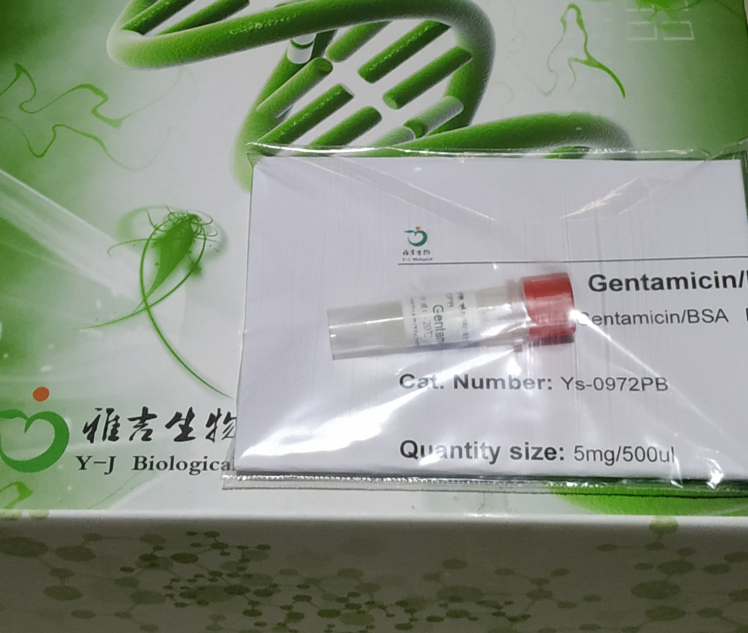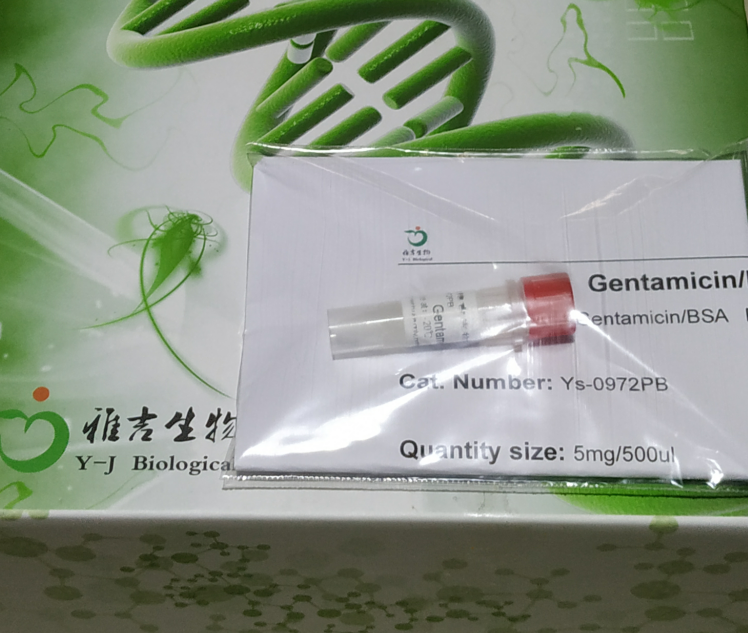| 英文名稱 | Dengue Virus NS1 |
| 中文名稱 | 登革熱病毒2糖蛋白NS1抗體 |
| 別 名 | polyprotein [Dengue virus 2]; Genome polyprotein; Dengue Virus NS1 glycoprotein; Dengue Virus non-structural protein 1; Dengue NS1; POLG_DEN26; Non-structural protein 1; |
| 研究領域 | 細菌及病毒 糖蛋白 |
| 抗體來源 | Rabbit |
| 克隆類型 | Polyclonal |
| 產品應用 | WB=1:500-2000 ELISA=1:500-1000 IHC-P=1:100-500 IHC-F=1:100-500 ICC=1:100-500 IF=1:100-500 (石蠟切片需做抗原修復) not yet tested in other applications. optimal dilutions/concentrations should be determined by the end user. |
| 分 子 量 | 40kDa |
| 細胞定位 | 分泌型蛋白 |
| 性 狀 | Liquid |
| 濃 度 | 1mg/ml |
| 免 疫 原 | KLH conjugated synthetic peptide derived from human Dengue Virus NS1:801-900/3391 |
| 亞 型 | IgG |
| 純化方法 | affinity purified by Protein A |
| 儲 存 液 | 0.01M TBS(pH7.4) with 1% BSA, 0.03% Proclin300 and 50% Glycerol. |
| 保存條件 | Shipped at 4℃. Store at -20 °C for one year. Avoid repeated freeze/thaw cycles. |
| PubMed | PubMed |
| 產品介紹 | NS1 is one of 7 Dengue Virus non-structural proteins which are thought to be involved in viral replication. NS1 exists as a monomer in its immature form but is rapidly processed in the endoplasmic reticulum to form a stable dimer. A small amount of NS1 remains associated with intracellular organelles where it is thought to be involved in viral replication. The rest of NS1 is found either associated with the plasma membrane or secreted as a soluble hexadimer. NS1 is essential for viral viability but its precise biological function is unknown. Antibodies raised in response to NS1 in viral infection can cross react with cell surface antigens on epithelial cells and platelets and this has been implicated in the development of Dengue Hemorrhagic fever. Function: prM acts as a chaperone for envelope protein E during intracellular virion assembly by masking and inactivating envelope protein E fusion peptide. prM is matured in the last step of virion assembly, presumably to avoid catastrophic activation of the viral fusion peptide induced by the acidic pH of the trans-Golgi network. After cleavage by host furin, the pr peptide is released in the extracellular medium and small envelope protein M and envelope protein E homodimers are dissociated. Envelope protein E binding to host cell surface receptor is followed by virus internalization through clathrin-mediated endocytosis. Envelope protein E is subsequently involved in membrane fusion between virion and host late endosomes. Synthesized as a homodimer with prM which acts as a chaperone for envelope protein E. After cleavage of prM, envelope protein E dissociate from small envelope protein M and homodimerizes. Non-structural protein 1 is involved in virus replication and regulation of the innate immune response. Soluble and membrane-associated NS1 may activate human complement and induce host vascular leakage. This effect might explain the clinical manifestations of dengue hemorrhagic fever and dengue shock syndrome. Non-structural protein 2A may be involved viral RNA replication and capsid assembly (Potential). Non-structural protein 2B is a required cofactor for the serine protease function of NS3. Serine protease NS3 displays three enzymatic activities: serine protease, NTPase and RNA helicase. NS3 serine protease, in association with NS2B, performs its autocleavage and cleaves the polyprotein at dibasic sites in the cytoplasm: C-prM, NS2A-NS2B, NS2B-NS3, NS3-NS4A, NS4A-2K and NS4B-NS5. NS3 RNA helicase binds RNA and unwinds dsRNA in the 3' to 5' direction. Non-structural protein 4A induces host endoplasmic reticulum membrane rearrangements leading to the formation of virus-induced membranous vesicles hosting the dsRNA and polymerase, functioning as a replication complex. NS4A might also regulate the ATPase activity of the NS3 helicase. Peptide 2k functions as a signal peptide for NS4B and is required for the interferon antagonism activity of the latter. Non-structural protein 4B inhibits interferon (IFN)-induced host STAT1 phosphorylation and nuclear translocation, thereby preventing the establishment of cellular antiviral state by blocking the IFN-alpha/beta pathway (By similarity). RNA-directed RNA polymerase NS5 replicates the viral (+) and (-) genome, and performs the capping of genomes in the cytoplasm. NS5 methylates viral RNA cap at guanine N-7 and ribose 2'-O positions. Besides its role in genome replication, also prevents the establishment of cellular antiviral state by blocking the interferon-alpha/beta (IFN-alpha/beta) signaling pathway. Inhibits host TYK2 and STAT2 phosphorylation, thereby preventing activation of JAK-STAT signaling pathway. Subunit: Capsid protein C forms homodimers. prM and envelope protein E form heterodimers in the endoplasmic reticulum and Golgi. In immature particles, there are 60 icosaedrally organized trimeric spikes on the surface. Each spike consists of three heterodimers of envelope protein M precursor (prM) and envelope protein E. NS1 forms homodimers as well as homohexamers when secreted. NS1 may interact with NS4A. NS3 and NS2B form a heterodimer. NS3 is the catalytic subunit, whereas NS2B strongly stimulates the latter, acting as a cofactor. In the absence of the NS2B, NS3 protease is unfolded and inactive. NS3 interacts with unphosphorylated NS5; this interaction stimulates NS5 guanylyltransferase activity. NS5 interacts with host STAT2; this interaction inhibits the phosphorylation of the latter, and, when all viral proteins are present (polyprotein), targets STAT2 for degradation. Subcellular Location: Capsid protein C: Virion (Potential). Peptide pr: Secreted. Small envelope protein M: Virion membrane; Multi-pass membrane protein. Host endoplasmic reticulum membrane; Multi-pass membrane protein. Envelope protein E: Virion membrane; Multi-pass membrane protein. Host endoplasmic reticulum membrane; Multi-pass membrane protein. Non-structural protein 1: Secreted. Host endoplasmic reticulum membrane; Peripheral membrane protein; Lumenal side. Non-structural protein 2A-alpha: Host endoplasmic reticulum membrane; Multi-pass membrane protein (Potential). Non-structural protein 2A: Host endoplasmic reticulum membrane; Multi-pass membrane protein (Potential). Serine protease subunit NS2B: Host endoplasmic reticulum membrane; Peripheral membrane protein; Cytoplasmic side. Serine protease NS3: Host endoplasmic reticulum membrane; Peripheral membrane protein; Cytoplasmic side. Note=Remains non-covalently associated to NS3 protease. Non-structural protein 4A: Host endoplasmic reticulum membrane; Multi-pass membrane protein. Note=Located in RE-associated vesicles hosting the replication complex. Non-structural protein 4B: Host endoplasmic reticulum membrane; Multi-pass membrane protein. RNA-directed RNA polymerase NS5: Host endoplasmic reticulum membrane; Peripheral membrane protein; Cytoplasmic side. Host nucleus. Note=Located in RE-associated vesicles hosting the replication complex. Post-translational modifications: Specific enzymatic cleavages in vivo yield mature proteins. The nascent protein C contains a C-terminal hydrophobic domain that act as a signal sequence for translocation of prM into the lumen of the ER. Mature protein C is cleaved at a site upstream of this hydrophobic domain by NS3. prM is cleaved in post-Golgi vesicles by a host furin, releasing the mature small envelope protein M, and peptide pr. Non-structural protein 2A-alpha, a C-terminally truncated form of non-structural protein 2A, results from partial cleavage by NS3. Peptide 2K acts as a signal sequence and is removed from the N-terminus of NS4B by the host signal peptidase in the ER lumen. Signal cleavage at the 2K-4B site requires a prior NS3 protease-mediated cleavage at the 4A-2K site. RNA-directed RNA polymerase NS5 is phosphorylated on serines residues. This phosphorylation may trigger NS5 nuclear localization. Envelope protein E and non-structural protein 1 are N-glycosylated. Similarity: In the N-terminal section; belongs to the class I-like SAM-binding methyltransferase superfamily. mRNA cap 0-1 NS5-type methyltransferase family. Contains 1 helicase ATP-binding domain. Contains 1 helicase C-terminal domain. Contains 1 mRNA cap 0-1 NS5-type MT domain. Contains 1 peptidase S7 domain. Contains 1 RdRp catalytic domain. SWISS: P29990 Gene ID: 1494449 Important Note: This product as supplied is intended for research use only, not for use in human, therapeutic or diagnostic applications. |
我要詢價
*聯系方式:
(可以是QQ、MSN、電子郵箱、電話等,您的聯系方式不會被公開)
*內容:









